Living in a studio apartment doesn’t mean giving up comfort or style. With thoughtful design, small spaces can actually feel more open, organized, and personalized than larger ones.
Whether you live alone or with someone else, smart design strategies—like using multi-purpose furniture and optimizing layout—can turn a compact studio into a cozy and efficient home.
The secret is to combine beauty with function: choose items that serve multiple roles, make use of vertical space, and maximize natural light.
Even the smallest corners can be transformed into practical, stylish areas.
This article offers 23 creative tips to help you make your studio apartment feel spacious and full of character, whether you’re starting fresh or updating your current setup.
1. Open Shelving That Doubles as a Divider

Using open shelving is a clever way to divide different areas in a studio apartment.
A tall bookcase placed between the bedroom and living space can act as a room divider without blocking light or making the room feel cramped.
It offers valuable storage while keeping the space bright and open.
Opt for double-sided shelves to display items like books, plants, or decor for both practical use and added style.
Read More: 30 Garage Organization Ideas
2. Lofted Bed with Built-In Storage and Workspace
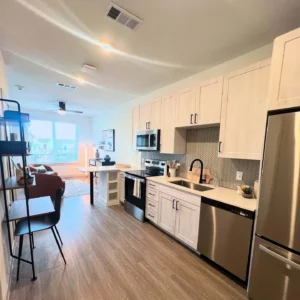
This lofted bed design makes smart use of vertical space by raising the bed and creating a functional area beneath it.
Perfect for students or those who work from home, it combines a sleeping area with storage and a workspace in one compact setup.
Features like under-bed drawers, a desk, and built-in lighting enhance its practicality.
It’s a great example of maximizing space by building up rather than out in a small studio.
3. Minimalist Scandinavian Vibes
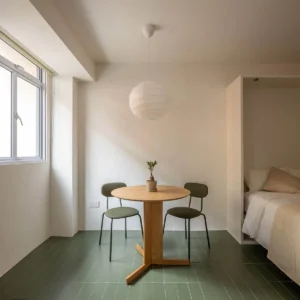
Adopting a minimalist Scandinavian design can help a studio apartment feel calm and roomy.
The look features soft, neutral tones like white, beige, and natural wood, combined with sleek, functional furniture.
Clean lines, minimal clutter, and textured layers define the style. A few cozy fabrics and some greenery add warmth and comfort while preserving an open, airy feel.
This approach focuses on simplicity, light, and balance—ideal for small spaces.
4. Clever Bed Nook with Curtains
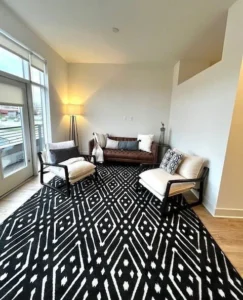
This setup cleverly uses curtains to create a separate sleeping area in a studio apartment.
Floor-to-ceiling drapes form a private, cozy bed nook that mimics the feel of a hotel room without adding permanent walls.
The design is flexible—you can draw the curtains for privacy or leave them open to keep the space feeling open and airy.
It’s a great solution for renters who want to define different zones without making structural changes.
5. Compact Yet Stylish Kitchenette
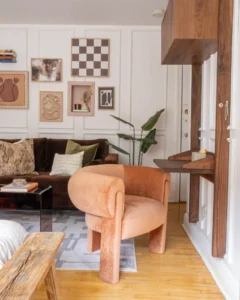
This image highlights a stylish and efficient kitchenette designed for small-space living.
Streamlined cabinets, a space-saving stovetop, and hidden appliances keep the area tidy and uncluttered.
Consistent colors and materials help it flow naturally with the rest of the studio, making the space feel cohesive.
Adding open shelving or wall organizers maximizes function by keeping everyday items easily accessible without using up counter space.
It shows that even a tiny kitchen can be both practical and chic.
Read More: 10 Creative Entryway Decor Ideas to Transform Your Space Instantly
6. Fold-Out Dining Table for Flexible Living
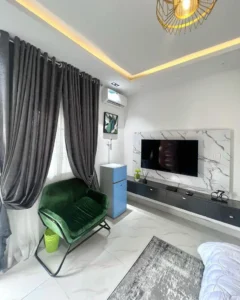
In a studio apartment, smart furniture choices are key, and a wall-mounted fold-out dining table is a great solution.
It folds flat when not in use, saving valuable floor space, and easily opens up into a compact dining or work area when needed.
When combined with stackable or folding chairs, the setup stays practical without adding clutter.
It’s perfect for those who want the option of sit-down meals or a flexible workspace in a small living area.
7. Light-Filled Corner with Layered Textures
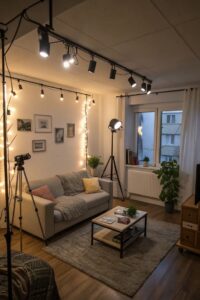
This peaceful studio corner shows how layering soft textures can add depth and coziness to a small space.
Sheer curtains, textured bedding, cozy throws, and woven details turn a basic bed area into a relaxing retreat.
The abundance of natural light amplifies the serene atmosphere.
By focusing on tactile elements in neutral tones, the space feels warm and inviting without becoming visually cluttered.
8. Statement Lighting for Personality and Function
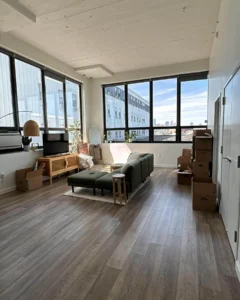
Lighting plays a crucial role in setting the mood of a studio apartment.
This design uses a striking pendant light to draw attention upward, making the ceiling feel higher and adding a dramatic focal point.
In small spaces, lighting isn’t just decorative—it helps define different zones for activities like cooking, relaxing, or working.
By layering ambient, task, and accent lighting, you can boost both style and function, while one bold fixture adds character without taking up space.
9. Vertical Garden for a Breath of Fresh Air
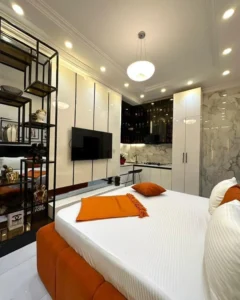
This studio cleverly brings nature indoors with a vertical garden, ideal for spaces lacking room on windowsills.
Wall-mounted planters filled with greenery add a refreshing, lively touch without taking up floor space.
Easy-care plants like pothos, ferns, or herbs work well in small containers and also help purify the air.
These green elements not only enhance the atmosphere but also add color and energy to otherwise neutral interiors.
10. Sofa Bed That Doesn’t Sacrifice Style
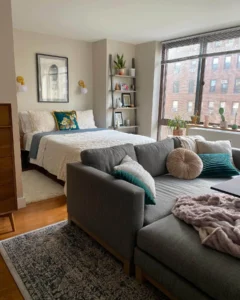
Today’s sofa beds are far from outdated or bulky, as shown in this image of a sleek, modern design that doubles as both seating and a bed.
By day, it blends effortlessly into a chic living area; by night, it transforms into a comfortable sleeping space.
Featuring clean lines, soft cushions, and built-in storage, it’s a perfect example of functional furniture that also looks great.
Opting for versatile pieces like this helps maximize utility while keeping your studio stylish and cohesive.
11. Glass Partition for Light and Separation
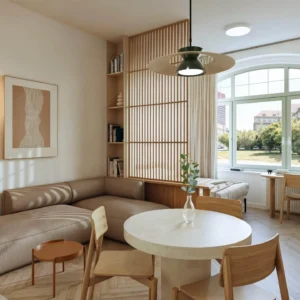
This studio smartly separates the sleeping area with a glass partition, allowing light to pass through while still creating distinct zones.
Unlike solid dividers, glass keeps the space feeling open and airy. It’s an ideal option for those who want privacy without blocking natural light or airflow.
Adding frosted or black-framed panels can enhance the design with a modern, architectural touch.
12. Platform Bed with Hidden Storage Drawers
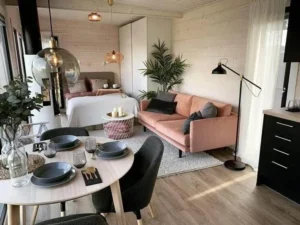
Raising the bed on a platform with built-in storage drawers is an effective way to maximize space in a studio apartment.
The platform creates a defined, tidy sleeping area while offering hidden storage for items like clothing, bedding, or off-season essentials.
This setup reduces the need for extra furniture, such as dressers, helping to maintain an open and uncluttered layout.
It’s a practical solution that adds both functionality and visual order to a compact living space.
13. Dual-Purpose Console Table
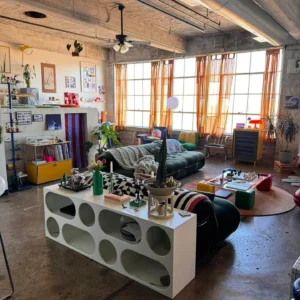
A slim console table is a versatile addition to a studio apartment, offering function without taking up much space.
This setup shows how it can double as a compact desk or a stylish surface for decor.
Add a stool and a lamp to create a quick workstation, or use it to display art, books, or plants in an entryway.
Its narrow design keeps the space feeling open while boosting both practicality and style.
14. Cozy Window Seating with Built-In Storage
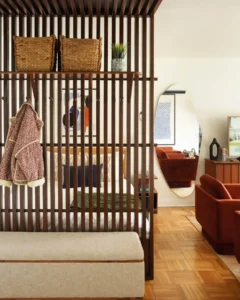
This image beautifully highlights how a window nook can be transformed into a functional and inviting space.
By adding cushions, the nook becomes a cozy reading spot, while the base serves as hidden storage with drawers or lift-up benches for items like books and blankets.
It’s a clever way to utilize an often-overlooked area, combining comfort and storage without taking up extra room.
This thoughtful design makes the most of the limited space in a studio apartment.
15. Neutral Color Palette with Strategic Accents
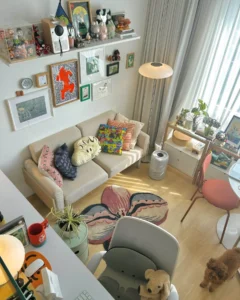
Using a consistent neutral color palette—such as soft grays, whites, and tans—creates a sense of openness and harmony in a small studio.
This design incorporates subtle pops of color, like a rust-toned throw or bold artwork, to add interest without cluttering the space.
By keeping vivid accents limited to a few focal points, the overall look remains calm and cohesive.
This approach is ideal for making compact living areas feel more expansive and serene.
16. Corner Desk Nook That Works Hard
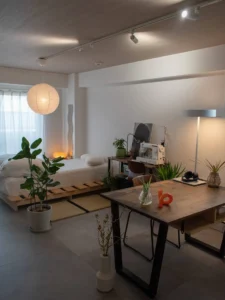
Finding space for a desk in a studio can be tricky, but this design makes it look effortless by turning a quiet corner into a practical work area.
A compact desk fits neatly into a wall niche, while floating shelves above provide storage for supplies and decorative touches.
With minimalist styling and plenty of natural light, the space feels open and welcoming.
For anyone working from home or needing a focus zone, creating a small desk nook like this is a smart, space-saving solution.
17. Monochrome Magic for Visual Cohesion
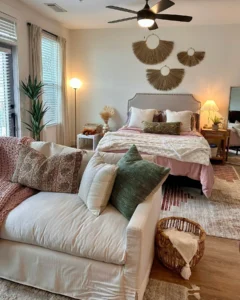
This studio embraces a black-and-white color scheme to create a striking yet cohesive look.
Sticking to a limited palette keeps the space feeling clean and organized, even with layered furniture and decor.
The key to avoiding a flat or harsh feel is texture—soft rugs, matte surfaces, and varied materials add depth and character.
This monochrome approach brings a sense of style and unity to a small apartment, making it feel both bold and thoughtfully designed.
Read More: 12 Fall Kitchen Decor Ideas to Warm Up Your Space This Season
18. Compact Entryway with Smart Storage
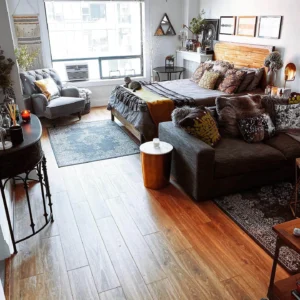
Even in a compact studio, a defined entryway can make a big difference, as shown in this image featuring a slim bench and wall-mounted organizer.
With hooks, cubbies, and trays, it keeps everyday items like keys, bags, and shoes neatly stored and easy to grab.
This small “landing zone” helps reduce clutter and brings a sense of order to the space. It also adds a welcoming, homey touch right at the entrance.
19. Earthy Tones and Natural Materials
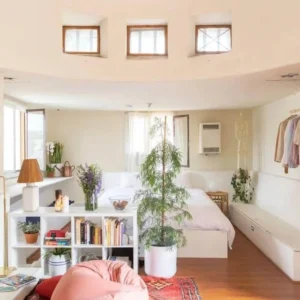
Incorporating natural elements into interior design is especially effective in small studios.
This space uses earthy tones like olive green, terracotta, and sand, along with organic materials such as rattan, linen, and raw wood.
The combination creates a soothing, grounded environment that feels both cozy and personal.
These light-reflecting, understated elements help maintain a spacious feel while adding warmth and character, perfect for minimalist living.
20. Stylish Murphy Bed That Disappears on Demand
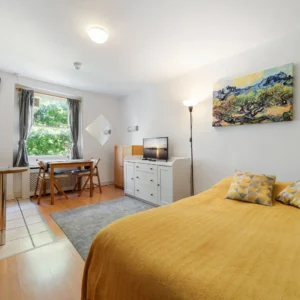
A Murphy bed is a classic solution for studios, and this modern version proves how far the design has come.
Sleek cabinetry conceals the bed when it’s not in use, freeing up floor space for entertaining or exercising.
Built-in shelves and integrated lighting add convenience and style.
It’s a big win for those who need their studio to perform multiple roles—from bedroom to living room to office—without skipping a beat.
21. Mirrors to Expand and Brighten the Room
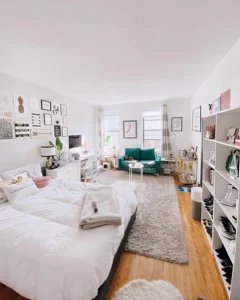
Well-positioned mirrors can significantly elevate the sense of space in a small studio.
This example features a large floor mirror that bounces natural light around the room, enhancing brightness and making the space appear larger.
Placing mirrors near windows maximizes sunlight, while mirrored accents or furniture introduce a touch of shine without adding bulk.
Whether wall-mounted or free-standing, reflective surfaces are a simple yet powerful tool for opening up a compact living area.
22. Statement Wall to Anchor the Layout
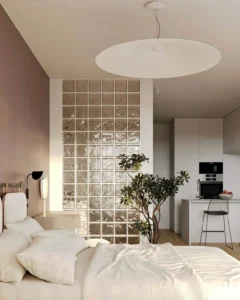
Adding a statement wall is a great way to define space and express personality in a studio apartment.
This design uses a bold wallpaper print behind the bed to create a visual “zone,” separating it from the rest of the room without physical dividers.
A feature wall like this draws the eye, adds character, and can help anchor your layout, making the overall space feel more intentional and stylish.
23. Floating Furniture for a Light, Airy Feel
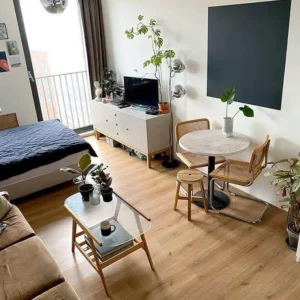
Floating furniture—like wall-mounted nightstands or vanities—can make a small space feel larger by keeping the floor visible and accessible.
In this setup, minimal floating shelves replace bulky side tables, offering surface space for essentials while contributing to a sleek, modern look.
Keeping furniture “off the ground” visually declutters the room and enhances the sense of openness. It’s a small change with a big design impact.

